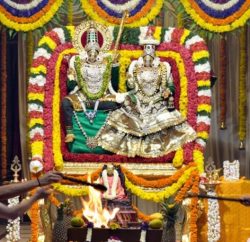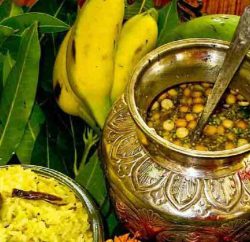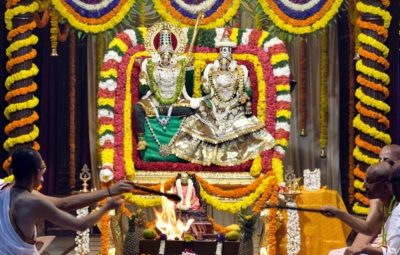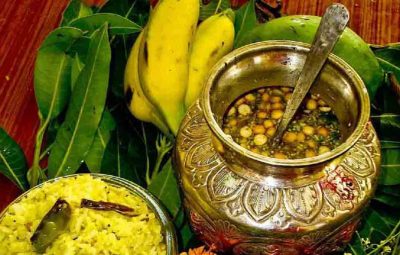Shiva-ratri means the night of Lord Shiva. In the Vedic month of Phalgun (February-March) there is a Maha Shivaratri. The ceremony takes place mainly at night. This festival is observed in honour of Lord Shiva, who was married to Parvati (Mother Durga/Mother Gauri) on this day.
Some devotees observe a strict fast on this day. They stay awake the whole night. The Shiva linga is worshipped throughout the night by bathing it every three hours with milk, yogurt, ghee, honey, etc., whilst chanting of the mantra “Om namah shivaya” continues. Bilva leaves are offered to the linga. These leaves are very sacred (as Tulasi is to Lord Krishna) and Lord Shiva becomes pleased with that offering. Many hymns glorifying Lord Shiva are sung with devotion.
He who utters the names of Lord Shiva during Shivaratri with perfect devotion and concentration is freed from all sins and he reaches the abode of Lord Shiva and resides very happily there.
NOTE: The Vaishnava/ aspiring Vaishnava however, worships Lord Shiva on this day in order to receive His blessings to become a better devotee of Lord Krishna and not to attain residence in the abode of Shiva.
Srila Prabhupada on Shivaratri and its observance
Once upon a time, the cowherd men of Vrindavana, headed by Nanda Maharaja, desired to go to Ambikavana to observe the Shivaratri ceremony. The rasa-lila was performed during the autumn, and after that the next big ceremony is Holi or the Dolayatra ceremony. Between the Dolayatra ceremony and the rasa-lila ceremony there is one important ceremony called Shivaratri, which is especially observed by the Shaivites, or devotees of Lord Shiva. Sometimes the Vaishnavas also observe this ceremony because they accept Lord Shiva as the foremost Vaishnava. But the function of Shivaratri is not observed very regularly by the bhaktas or devotees of Krishna.
Under the circumstances, it is stated in Srimad-Bhagavatam that Nanda Maharaja and the other cowherd men “once upon a time desired.” This means that they were not regularly observing the Shivaratri function but that once upon a time they wanted to go to Ambikavana out of curiosity. Ambikavana is somewhere in the Gujarat province, and it is said to be situated on the banks of river Sarasvati. Yet we do not find any Sarasvati river in the Gujarat province, although there is a river named Sabarmati. In India, all the big places of pilgrimage are situated on nice rivers like the Ganges, Yamuna, Sarasvati, Narmada, Godavari and Kaveri. Ambikavana was situated on the bank of Sarasvati, and Nanda Maharaja and all the other cowherd men went there.
They very devotedly began to worship the deity of Lord Shiva and Ambika. It is the general practice that wherever there is a temple of Lord Shiva, there must be another temple, of Ambika (or Durga), because Ambika is the wife of Lord Shiva and is the most exalted of chaste women. She doesn’t live outside the association of her husband. After reaching Ambikavana, the cowherd men of Vrindavana first bathed themselves in the river Sarasvati. If one goes to any place of pilgrimage, his first duty is to take a bath and sometimes to shave his head. That is the first business. After taking a bath, they worshiped the deities and then distributed charity in the holy places.
– Krishna Book, Chapter 34
maitreya uvaca
tada sarvani bhutani
srutva midhustamoditam
paritustatmabhis tata
sadhu sadhv ity athabruvan
– Srimad Bhagavatam 4.7.6
“In this verse Lord Shiva is described as midhustama, the best of the benedictors. He is also known as Asutosa, which indicates that he is very quickly satisfied and very quickly angered. It is said in Bhagavad-gita that less intelligent persons go to the demigods for material benedictions. In this connection, people generally go to Lord Shiva, and because he is always quickly satisfied and gives benedictions to his devotees without consideration, he is called midhustama, or the best of the benedictors. Materialistic persons are always anxious to get material profit, but they are not serious about spiritual profit.
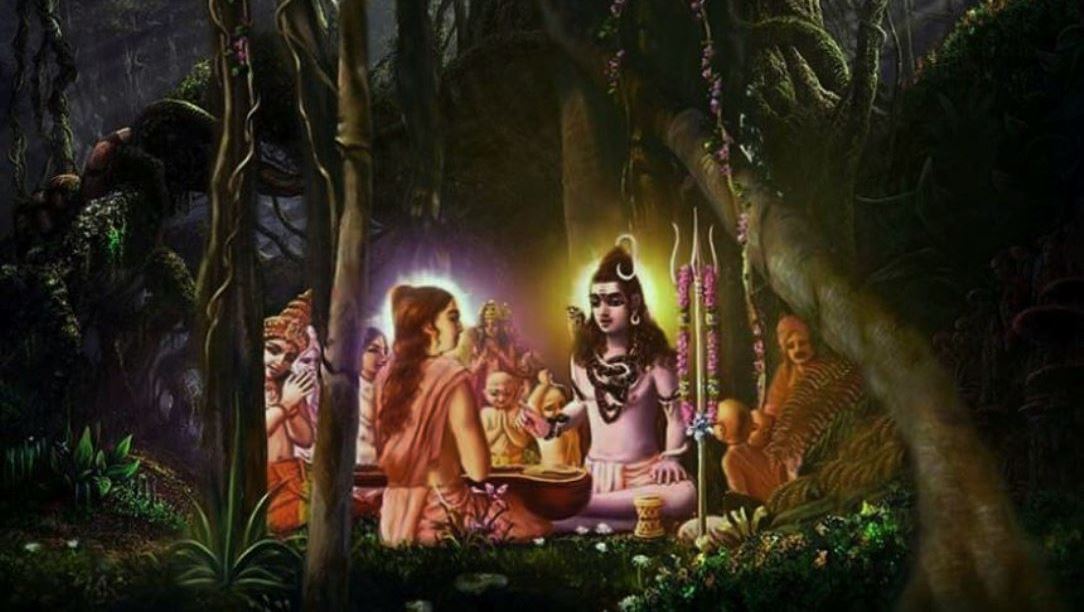
Sometimes, of course, it so happens that Lord Shiva becomes the best benedictor in spiritual life. It is said that once a poor brahmana worshiped Lord Shiva for a benediction, and Lord Shiva advised the devotee to go to see Sanatana Gosvami. The devotee went to Sanatana Gosvami and informed him that Lord Shiva had advised him to seek out the best benediction from him (Sanatana). Sanatana had a touchstone with him, which he kept with the garbage. On the request of the poor brahmana, Sanatana Gosvami gave him the touchstone, and the brahmana was very happy to have it. He now could get as much gold as he desired simply by touching the touchstone to iron.
But after he left Sanatana, he thought, “If a touchstone is the best benediction, why has Sanatana Gosvami kept it with the garbage?” He therefore returned and asked Sanatana Gosvami, “Sir, if this is the best benediction, why did you keep it with the garbage?” Sanatana Gosvami then informed him, “Actually, this is not the best benediction. But are you prepared to take the best benediction from me?” The brahmana said, “Yes, sir. Lord Shiva has sent me to you for the best benediction.” Then Sanatana Gosvami asked him to throw the touchstone in the water nearby and then come back. The poor brahmana did so, and when he returned, Sanatana Gosvami initiated him with the Hare Krishna mantra. Thus by the benediction of Lord Shiva the brahmana got the association of the best devotee of Lord Krishna and was thus initiated in the maha-mantra, Hare Krishna, Hare Krishna, Krishna Krishna, Hare Hare/ Hare Rama, Hare Rama, Rama Rama, Hare Hare.
– Srimad Bhagavatam 4:7:7. Purport
Vaishnavanam yatha Sambhuh – Lord Shiva is the greatest devotee of Lord Vishnu.
Lord Krishna (Vishnu) is in this analogy considered to be likened to Milk. Milk is the origin of so many dairy products – Krishna tu bhagavan swayam, and so Krishna or Vishnu is the origin of everything. When Krishna wants activity overseen of the modes of tamo guna He expands Himself transforming His supreme powers to act in that way, as no-one else could, and in that state He is Shambu – Shiva. So it may be seen that milk that is transformed becomes yogurt, but that yoghurt can never again become milk, this is presented in Brahma samhita 5:45.
PURPORT
(The real nature of Sambhu, the presiding deity of Mahesa-dhama, is described.) Sambhu is not a second Godhead other than Krishna. Those, who entertain such discriminating sentiment, commit a great offense against the Supreme Lord. The supremacy of Sambhu is subservient to that of Govinda; hence they are not really different from each other. The non-distinction is established by the fact that just as milk treated with acid turns into curd, so Godhead becomes a subservient when He Himself attains a distinct personality by the addition of a particular element of adulteration. This personality has no independent initiative. The said adulterating principle is constituted of a combination of the stupefying quality of the deluding energy, the quality of nonplenitude of the marginal potency and a slight degree of the ecstatic-cum-cognitive principle of the plenary spiritual potency.
This specifically adulterated reflection of the principle of the subjective portion of the Divinity is Sadashiva, in the form of the effulgent masculine-symbol-god Sambhu from whom Rudradeva is manifested. In the work of mundane creation as the material cause, in the work of preservation by the destruction of sundry asuras and in the work of destruction to conduct the whole operation, Govinda manifests Himself as guna-avatara in the form of Sambhu who is the separated portion of Govinda imbued with the principle of His subjective plenary portion. The personality of the destructive principle in the form of time has been identified with that of Sambhu by scriptural evidences that have been adduced in the commentary.
The purport of the Bhagavata slokas, viz., vaisnavanam yatha sambhuh, etc., is that Sambhu, in pursuance of the will of Govinda, works in union with his consort Durga devi by his own time energy. He teaches pious duties (dharma) as stepping-stones to the attainment of spiritual service in the various tantra-sastras, etc., suitable for jivas in different grades of the conditional existence. In obedience to the will of Govinda, Sambhu maintains and fosters the religion of pure devotion by preaching the cult of illusionism (Mayavada) and the speculative agama-sastras. The fifty attributes of individual souls are manifest in a far vaster measure in Sambhu and five additional attributes not attainable by jivas are also partly found in him. So Sambhu cannot be called a jiva. He is the lord of jiva but yet partakes of the nature of a separated portion of Govinda.
(Sri Brahma Samhita, translation by Srila Bhaktisiddhanta Saraswati Thakur Prabhupada.)
Related links: Maha Shivaratri: The most Auspicious Night of the Year


